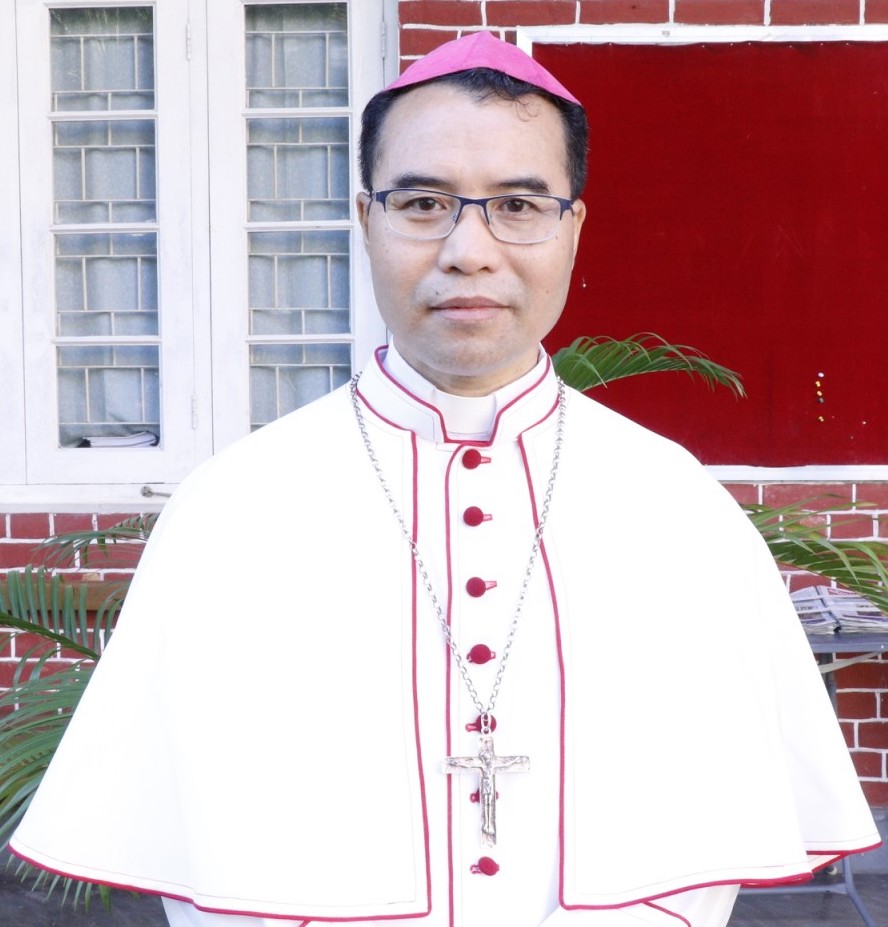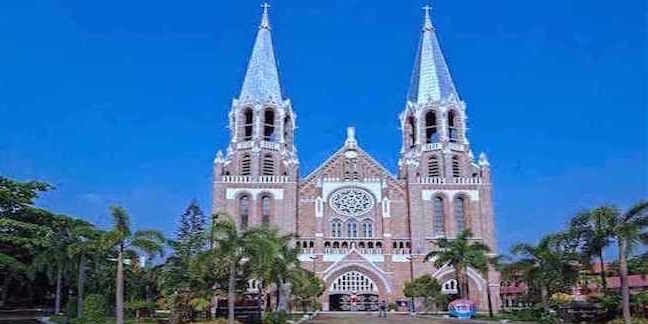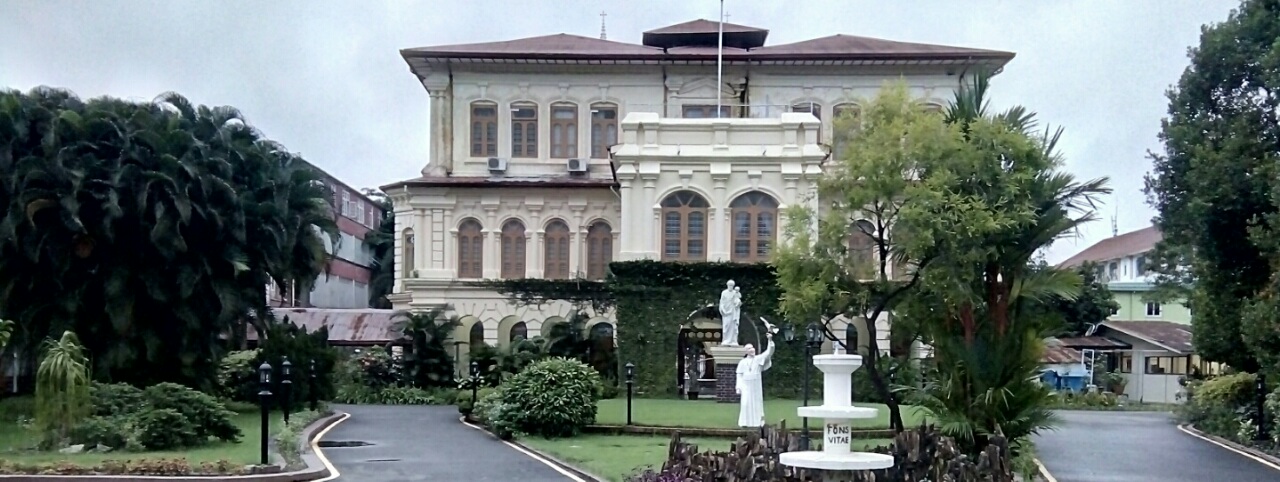


| (yangon Zone) | |
| Address: | 372, Bo Aung Kyaw Street Botahtaung Tsp, Yangon |
|---|---|
| Telephone: | +95 (0)1 245467, 392517, 392667 |
| Sunday Mass: | 6:00 a.m. (English) 8:00 a.m. (English) 5:00 p.m (Myanmar) |
| Daily Mass: | 6:00 a.m. (English) 5:00 p.m (English) |
| Priest in charges: |
Rev. Fr. William Soe Min Thu (assistant pastor) Rev. Fr. Albert Khin Maung Win (assistant pastor) His Excellency Bishop Francis Than Htun (rector) |
| Additional Informations and Services | confession |
| History: | |
|
St. Mary’s Cathedral (Immaculate Conception) For some time before his death, Bishop Paul Bigandet had been giving serious thought to the necessity of providing a place of worship for the ever increasing number of his flock in Rangoon. That the new structure should take the form of a metropolitan Cathedral of considerable size and of the best architectural design was the opinion of both clergy and laity. A suitable piece of land measuring over fifteen acres due east of St. Paul's High School was found and the Bishop submitted an application to the Government of Burma, asking permission to sell, as freehold, the site of the old Cathedral, with a view to the proceeds being entirely applied towards the expenditure of erecting the new Cathedral. The concession of the land applied for was in the Chief Commissioner's opinion excessive, but he was prepared to recommend that the Government should sanction the grant of so much of the remaining portion "on either side of St. Paul's as is as the disposal of the Government: viz., about five acres, as a site for a Roman Catholic Cathedral and subsidiary buildings, provided that the site of the present Cathedral is relinquished to the Government.” The Bishop in his reply pointed out that his plea to sell the site of the old Cathedral was based on similar concessions made by the Government, only a few years previously, to other Christian communities. It was, of course, for the Government to decide whether the Catholic community should be treated with equal liberality. In any case, the act would be one of grace, and not one which any community could claim as a right.
Two months later, on January 23, 1893, the Bishop was informed that the Government of India sanctioned the proposal to sell the site of the Cathedral at Barr Street and to appropriate the proceeds for the erection of a new one. Just prior to the commencement of his project, Bishop Bigandet was called to his Heavenly Home, and was succeeded by Bishop Cardot, who had the title-deeds signed by the Secretary to the Commissioner of the Revenue Department and himself. No time was lost in commencing the foundations of the future edifice. Under the supervision of Mr. H. Hoyne-Fox, consulting architect to the Burmese Government, plans for a Cathedral of the Byzantine model were drawn up. These plans provided for the erection of a fine dome over the junction of the nave, choir and trancepts. As the first efforts to sink the foundation resulted in the discovery of a pultaceous and yielding substratum. It was decided to drive down into the substratum a series of pyinkado piles, eighteen feet long and three feet in girth as a basis upon which to build. This tedious work was started in June, 1895 and concluded in January, 1899. While these important changes were in progress, Bishop Cardot, at the urgent advice of his doctors, was compelled to go to France. Mr. Hoyne-Fox was proceeding on long leave, and there was no one to replace him in carrying on the work of supervisor and consulting architect.
The Bishop, therefore, was asked to search in Europe for an architect. Among the students assembled for Ordination, one was noticeable for his pallid and worn aspect and emaciated figure. Bishop Cardot enquired as to his identity and learned that Rev. Janzen has been sent home on account of commencing pulmonary consumption two years previously, and was then, by permission presenting himself for Ordination to the priesthood, but could never be sent out to the foreign missions as his case had been pronounced incurable. Father Janzen had studied in the "Ecole Poly-technique" under Dr. Cuypers, an eminent Dutch architect, who had designed the State Museum at Amsterdam as well as most of the churches built in Holland during the last century. Dr. Cuypers was the originator of a style of architecture since termed “Style Necessaire’’. Father Janzen had collaborated with Dr. Cuyper's son, himself an architect, in the erection of the Amsterdam Museum. Bishop Cardot prevailed upon the authorities at Paris to allow Father Janzen to accompany him back to Rangoon. Father Janzen went to his native Holland to consult his old classmate, Dr. Cuypers, Jr. who prepared a new plan for a French Catholic Cathedral in the "Style Necesssaire".
In November, 1898, Bishop Cardot and Father Janzen arrived at Rangoon. To adapt the existing foundation to the new plan, Father Janzen at once set about to extend them. As a basis for the chancel and apse a layer of sand nine feet in depth was substituted for pyinkado piles while an additional hundred of the latter were driven down to strengthen and support the rest. The altered structure was to be thirty feet longer and capable of seating 1,500 people. The corner stone of white marble was solemnly blessed and laid by Bishop Cardot on Sunday, November 19, 1899. Father Janzen found only bricks and cement, an army of untrained coolies and a few Chinese maistries. He made use of the material he could lay his hands on and trained and directed his men. He simplified their labor by providing them with wooden rules, frames, and other devices to render their operations more mechanical and exact. By the aid of reinforced concrete and wooden moulds he fabricated tiles and decorative blocks of every description. Many of them he bored through to make them lighter and to save material in such a way, however as to interfere in no way with their strength and solidity. The towers had no sooner been completed than they sank two feet under their own weight, causing serious cracks in the groined roofing of the aisles and in the triforium of the nave. Father Janzen sawed through the connection between the towers and the rest of the edifice from top to bottom so as not to damage the main structure. The sinking slowly continued, so much so that Father Janzen abandoned the idea of adding spires. Fortunately the sinking stopped for more than a year and Father Janzen began the work of constructing the spires, 86 feet above the towers.
On August 11, 1907, he slipped on a plank and fractured his thigh in three places. Father Janzen came out of the hospital permanently crippled. Thanks however, to the intelligent supervision of the Chinese maistry Ah Yen, who for the preceding eight years had been his principal assistant, the work of construction continued. The Most Rev. Dr. Kelly, Coadjutor Archbishop of Sydney had this to say in the "Catholic Press of Sydney", of the Cathedral and Father Janzen: "The Cathedral at Rangoon, now almost complete in the exterior outline, is a work of genius. It has twin spires rising from its facade, and so setting their surmounting crosses as to draw the visitor's attention ... Father Janzen lives hidden away in his single room in the ground floor having but the plainest technical apparatus, restricted to very scanty funds, and quite uncertain as to the future. For many months he has been deprived the consolation of celebrating Mass, on account of a fractured limb, which no longer serves for .standing at the altar. Yet, the Cathedral works and keeps going; designs are forthcoming as required by each detail of workmanship; expedients for overcoming difficulties and for accommodating disarrangements are invented; and many cruxes, which have nonplussed professional skill in Burma, have been successfully dealt with by the wonderful spirit that dwells in the dying and broken body of this devoted priest.”
On August 1, 1911, Father Janzen died and was interred at the entrance to the nave of the Cathedral. A plain inlaid marble slab indicated the spot whereafter "life's fitful fever, he sleeps well". What better spot could have been chosen to lay him to rest than within the walls of that magnificent edifice. And yet by an irony of fate, he lies there forgotten by the hundreds of Catholics who flock almost daily to the Cathedral, whilst the non-Catholic visitor, mindful that he is in a place of worship and desirous of seeing the architectural beauties of the interior, stands in hushed and respectful silence at the foot of the grave and pays his genius at least the passing tribute of a sigh. The earthquake of May 5, 1930 wrought havoc in the city. The Cathedral behaved splendidly under the shock it received. Only two interior vaults came down and others showed a few cracks. Two arches next to the towers were badly cracked but in a few months repairs were completed. The Cathedral well withstood the Japanese bombings of 1941-42 but the Allied bombing of December 14, 1944, blew all the beautiful stained glasses to smithereens. Today it would cost a fortune to have them replaced. Saint Mary's Cathedral today stands as a glorious monument to the indomitable purpose and genius of Reverend Father Hendrick Janzen, its architect, and to the faith and generosity of the Catholics of the Archdiocese of Rangoon. The marble slab on the wall of the Church indicates that the Catholics of the vicariate of Southern Burma built this Cathedral Church with their own funds, and by the zeal and especially the genius of Rev. Fr. H. Janzen. Its foundation stone was blessed on the 19th November 1899. The Church itself was solemnly blessed on 21st November 1909, and Consecrated and Dedicated on 22nd February 1910. The names of the chief donors were written on it, and it was signed by Rev. Fr. P. St. Guily.
The feast of St. Mary’s Cathedral is celebrated on the Feast of the Immaculate Conception, which falls on 8 December. According to the 2004 statistics there are 700 Catholics registered in this Cathedral parish, yet the Catholics from different parishes and places attend the liturgical services in this Cathedral.
|
|




